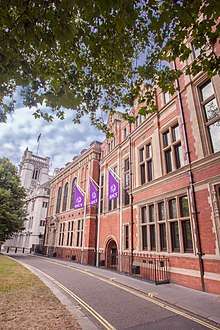Royal Institution of Chartered Surveyors
 | |
 | |
| Motto |
Est modus in rebus ("There is measure in all things") |
|---|---|
| Formation | 1868 |
| Type | Professional body |
| Headquarters |
London, SW1 United Kingdom |
| Coordinates | 51°30′3″N 0°7′41″W / 51.50083°N 0.12806°WCoordinates: 51°30′3″N 0°7′41″W / 51.50083°N 0.12806°W |
Region served | Worldwide |
Membership | 125,000 (2018) |
Chief Executive Officer | Sean Tompkins |
President (2017-18) | John Hughes |
Staff | c. 900 |
| Website |
www |
The Royal Institution of Chartered Surveyors (RICS) is a professional body that accredits professionals within the land, property, construction, and infrastructure sectors worldwide.
Professionals holding RICS qualifications may use the following designations after their name: MRICS (Member), FRICS (Fellow), AssocRICS (Associate). Those with the designation MRICS or FRICS are also known as chartered surveyors.
History
RICS was founded in London as the Institution of Surveyors after a meeting of 49 surveyors at the Westminster Palace Hotel on 15 June 1868. The inaugural president was John Clutton (who founded Cluttons, a property firm still in business today). The organisation has occupied headquarters on the corner of Great George Street and Parliament Square since then.[1] It received a Royal charter as The Surveyors' Institution on 26 August 1881.[2][note 1]
The Surveyors' Institution became the Chartered Surveyors' Institution in 1930.[3] In 1946, George VI granted the title "Royal" and in 1947 the professional body became the Royal Institution of Chartered Surveyors.[4]

International presence
RICS headquarters is in London with its main support functions in Birmingham. There are regional offices in the United Kingdom, across mainland Europe, in China, Hong Kong, Singapore, Australia, the Middle East, Sub-Saharan Africa, North America and Brazil.
In 2018, there are RICS-qualified professionals in nearly 150 countries. RICS accredits 125,000 qualified and trainee professionals worldwide[5]. The majority of accredited individuals are still based in the United Kingdom with large numbers also in mainland Europe, Australia and Hong Kong. There is now a strong growth globally, particularly in China, India and the Americas.
RICS has close links with many national surveying institutions and is a founding member association of the International Federation of Surveyors (FIG). Within RICS the primary areas of practice represented at FIG are geomatics (land and hydrographic survey), environment, planning, construction and valuation.
RICS works in close collaboration with other professional bodies, central banks and international organisations such as The United Nations, World Bank and The European Union.
International standards
In 2013, RICS was a founder member of the coalition to develop International Property Measurement Standards, which launched its first standard – for measuring office space – in November 2014. It launched its second standard, for measuring residential buildings, in September 2016. In 2014 RICS was a founder member of the coalition to develop International Ethics Standards[6], standards designed to add greater consistency to developing and reinforcing professional ethics globally – these launched in December 2016.
To add greater consistency to the benchmarking, measuring, and reporting of construction project costs, International Construction Measurement Standards[7] published in July 2017. And the coalition for International Land Measurement Standards – to add consistency to the interpretation and documentation of tenure – launched in June 2016. In each case, coalition member bodies are committed to implementing the new standards through training and guidance for professional practitioners.
Membership
Entry to membership of RICS is via four main routes: academic; graduate; technical; and senior professional. RICS has links with universities worldwide, with whom they have accredited approved courses which satisfy part of the qualification requirements to become trainee surveyors. RICS also offers expedited routes to membership for qualified professional members of some partner associations.
RICS requires members to update their knowledge and competence during their working life through Continuing Professional Development.
- Associate members may use "AssocRICS" after their names (previously members at this level were known as Technical Members and used the designation "TechRICS").[8]
- Professional Members may use "MRICS" after their names (previously members at this level were known as Professional Associates and used the designation "ARICS").
- Fellows may use "FRICS" after their names.
- Honorary members may use “HonRICS” after their names.
Individuals holding the professional MRICS or FRICS designation are entitled to use the professional title designation "Chartered Surveyor" and variations such as "Chartered Building Surveyor" or "Chartered Quantity Surveyor", depending on their chosen specialist qualifications and field of expertise.
Professional groups
RICS specifies areas of specialism, each with its own professional group, clustered into Land, Property and Construction. Within each professional group there may be further specialisms.[9]
| Property Professional Groups | Land Professional Groups | Built Environment Professional Groups |
|---|---|---|
| Arts & Antiquities | Environment | Building Control |
| Commercial Property | Geomatics | Building Surveying |
| Dispute Resolution | Minerals & Waste | Project Management |
| Facilities Management | Planning & Development | Quantity Surveying & Construction |
| Machinery & Assets | Rural | Dilapidations forum |
| Management Consultancy | Telecom forum | Insurance forum |
| Residential property | ||
| Valuation | ||
| Building conservation forum |
Specialist accreditations
RICS aims to cover, among its practising members, property and construction related expertise generally. Specialised areas of practice expertise for which accreditation is available include:
- Building Information Modelling (BIM) Manager Certification
- Building Conservation
- Chartered Environmentalists
- Dispute Resolution
- ECO Assessor Certification
- Fixed Charge Receivership Scheme
- Valuer Registration.
Past Presidents
Recent Presidents of RICS have included Amanda Clack, Martin J Brühl, Michael Newey, Alan Collett, See Lian Ong, and Robert Peto. The first female President of RICS was Louise Brooke-Smith who was elected in 2014. [10]
RICS Matrics
The junior branch of RICS, known as Matrics (pronounced "matrix"), provides educational support, charitable and networking activities for surveying students, trainee surveyors (of any age) and Chartered Surveyors with ten years or less post-qualification experience.[11] It comprises some 40 local groups across the United Kingdom. Established in 1889 as the Junior Committee, it became the "Junior Organisation" ("JO") in 1928 and was re-branded as "RICS Matrics" in 2003. It also has links with the Young Chartered Surveyors in the Republic of Ireland.
BCIS
BCIS is the Building Cost Information Service of RICS. Established in 1962 BCIS provides independent cost and price information to the construction industry and anyone else who needs comprehensive, accurate and independent data.[12] BCIS pioneered elemental cost planning in the early 1960s that is now the basis of early cost advice in the construction industry today. The organisation holds the largest independent database of cost plans in elemental form.
Services, available to government bodies and private developers, include measuring price movement, benchmarking, market research, statistical analysis, forecasting, and impact studies, relatng to construction, maintenance, rebuilding and insurance. BCIS International offers survey-based cost information for markets outside the UK.
Charitable works
Lionheart is the benevolent fund for past and present RICS members and their families. The charity was established in 1899 and provides financial support, health and well-being packages, and work-related counselling and befriending support. RICS also supports the Chartered Surveyors Training Trust, which helps young people enter the profession through apprenticeships;[13] Charity Property Help, which provides property advice to charities and voluntary organisations,[14] and The Chartered Surveyors' Voluntary Service (CSVS), a registered charity providing free property advice to people who would otherwise struggle to access professional assistance.[15]
See also
- Chartered surveyors in the United Kingdom
- Construction Industry Council
- International Valuation Standards Committee, of which the RICS is a founding member
- Chartered Institute of Building, a sister professional body within the built environment
Notes
References
- ↑ "History". RICS. 2014. Archived from the original on 1 December 2014. Retrieved 27 September 2014.
- 1 2 "The Institution of Surveyors". The Times. The Times Digital Archive. 10 September 1881. p. 12. Retrieved 27 September 2014. (subscription required)
- ↑ "Chartered Surveyors". The Times. The Times Digital Archive. 15 November 1930. p. 8. Retrieved 27 September 2014. (subscription required)
- ↑ "Royal Institution of Chartered Surveyors". The Times. The Times Digital Archive. 28 May 1946. p. 8. Retrieved 27 September 2014. (subscription required)
- ↑ RICS. "Who we are and what we do". rics.org. RICS. Retrieved 2 January 2018.
- ↑ IES. "International Ethics Standards". IES coalition. IES. Retrieved 2 January 2018.
- ↑ ICMS. "International Construction Measurement Standards". ICMS coalition. Retrieved 2 January 2018.
- ↑ "AssocRICS – the new grade". RICS. 1 January 2009. Retrieved 2009-10-11.
- ↑ Professional Groups of the RICS
- ↑ A full list of past presidents
- ↑ RICS
- ↑ Designing Buildings Wiki, Last edited 08 Jul 2014
- ↑ RICS Archived 2015-05-18 at the Wayback Machine.
- ↑ RICS Archived 2015-05-18 at the Wayback Machine.
- ↑ RICS Archived 2015-05-18 at the Wayback Machine.